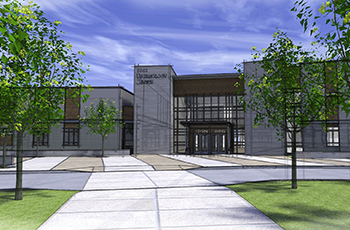Central Oregon Community College Enhances Tech Programs
 REDMOND, Ore. — Students returning to the Central Oregon Community College (COCC) Redmond Campus this fall can expect the latest in technology with the grand opening of the Redmond Technology Education Center on Sept. 16. The 34,000-square-foot building houses technology-centered programs that will help students gain skill sets required in today’s tech world.
REDMOND, Ore. — Students returning to the Central Oregon Community College (COCC) Redmond Campus this fall can expect the latest in technology with the grand opening of the Redmond Technology Education Center on Sept. 16. The 34,000-square-foot building houses technology-centered programs that will help students gain skill sets required in today’s tech world.
Construction on the $12.5 million project started in April 2013 and was completed earlier this summer. BBT Architects designed the facility, while Kirby Nagelhout Construction completed the construction. Both companies are based in Bend, Ore.
“Central Oregon Community College envisioned the new Redmond Technology Education Center as a key element in recruiting and expanding businesses in Central Oregon,” said Kevin Shaver, associate architect at BBT Architects. “By implementing technology-based education and training within their curriculum, they are advancing their students to learn the latest in technology-focused entrepreneurship and sustainability education.”
The Center for Entrepreneurial Excellence and Development (CEED) makes up about a third of the space in the new building. The program teaches students how to create and sustain a small business by instructing them about best business practices and the basics of starting and growing a small business.
A new two-year degree program, Automotive Technology in Electronics and Diagnostics (TED), is also available at the Redmond Technology Education Center. It focuses on electric and hybrid power systems, clean diesel and on-board vehicle networking — all of which are required to understand electronics in today’s vehicles. Programs in the progressive new field of nondestructive testing and nondestructive inspections are also available to help train students in the techniques for detecting internal or external defects, determining structure, composition and properties or measuring geometric characteristics. Students will be able to earn several one-year certificates or a two-year degree in nondestructive testing and inspection.
“There are three major visual connections that the design of this building capitalized upon,” Shaver said. “The scheme, which takes advantage of the visual connections, is based upon the programmatic information that delineated the three parts of functional needs. The resulting tripartite scheme exhibits the tech center spaces, CEED spaces and a third central core, which houses the theater lab, large classrooms and group study spaces.”
The first visual connection that Shaver described was that the Redmond Technology Education Center was designed to serve as a signature building on the COCC Redmond Campus as the public approaches the site from the west. That opportunity for the center to serve as a signature building was then exemplified by creating a solid mass punctuated by voids, which speak of a need for light in the more formal spaces of learning and business experimentation in the structure, Shaver said.
“BBT Architects selected a three-dimensional form that displays the acoustical properties of the learning theater space,” he said.
The third visual element appears when the public travels west on Airport Way. From here, the design highlights the high-tech laboratories by creating transparent forms that display the interior equipment and technology located within the building.
The facility was also designed to provide flexibility so that 10 years from now it can still support training in technologies that are unknown today. That flexibility includes multipurpose spaces as well as expansion space and large exterior access doors that make it easy to remove and install equipment.
